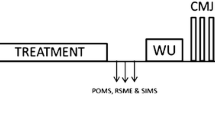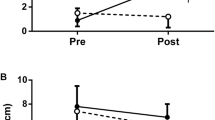Abstract
Mental fatigue (MF) does not only affect cognitive but also physical performance. This study aimed to explore the effects of MF on muscle endurance, rate of perceived exertion (RPE), and motor units’ activity. Ten healthy males participated in a randomised crossover study. The subjects attended two identical experimental sessions separated by 3 days with the only difference of a cognitive task (incongruent Stroop task [ST]) and a control condition (watching a documentary). Perceived MF and motivation were measured for each session at baseline and after each cognitive task. Four contractions at 20% of maximal voluntary contraction (MVIC) were performed at baseline, after each cognitive and after muscle endurance task while measuring motor units by high-density surface electromyography. Muscle endurance until failure at 50% of MVIC was measured after each cognitive task and the RPE was measured right after failure. ST significantly increased MF (p = 0.001) reduced the motivation (p = 0.008) for the subsequent physical task and also impaired physical performance (p = 0.044). However, estimates of common synaptic inputs and motor unit discharge rates as well as RPE were not affected by MF (p > 0.11). In conclusion, MF impairs muscle endurance and motivation for the physical task but not the neural drive to the muscle at any frequency bands. Although it is physiologically possible for mentally fatigued subjects to generate an optimal neuromuscular function, the altered motivation seems to limit physical performance. Preliminarily, our results suggest that the corticospinal pathways are not affected by MF.



Similar content being viewed by others
Data Availability
Data is available for readers.
Abbreviations
- HDsEMG:
-
High-density surface electromyography
- MF:
-
Mental fatigue
- MVIC:
-
Maximum voluntary isometric contraction
- RPE:
-
Ratings of perceived exertion
- ACC:
-
Anterior cingulate cortex
- EMG:
-
Electromyography
- ST:
-
Stroop task
- VAS:
-
Visual analogue scale
- PPS:
-
Pulse per second
References
Aitken B, MacMahon C (2019) Shared demands between cognitive and physical tasks may drive negative effects of fatigue: a focused review. Front Sport Act Living 1:45. https://doi.org/10.3389/fspor.2019.00045
Alix-Fages C, Del Vecchio A, Baz-Valle E et al (2022) The role of the neural stimulus in regulating skeletal muscle hypertrophy. Eur J Appl Physiol 122:1111–1128. https://doi.org/10.1007/s00421-022-04906-6
Boat R, Taylor IM (2017) Prior self-control exertion and perceptions of pain during a physically demanding task. Psychol Sport Exerc 33:1–6. https://doi.org/10.1016/j.psychsport.2017.07.005
Boksem MAS, Tops M (2008) Mental fatigue: costs and benefits. Brain Res Rev 59:125–139. https://doi.org/10.1016/j.brainresrev.2008.07.001
Boksem MAS, Meijman TF, Lorist MM (2006) Mental fatigue, motivation and action monitoring. Biol Psychol 72:123–132. https://doi.org/10.1016/j.biopsycho.2005.08.007
Bräcklein M, Barsakcioglu DY, Del Vecchio A et al (2022) Reading and modulating cortical β bursts from motor unit spiking activity. J Neurosci 42:3611–3621. https://doi.org/10.1523/JNEUROSCI.1885-21.2022
Bray SR, Martin Ginis KA, Hicks AL, Woodgate J (2008) Effects of self-regulatory strength depletion on muscular performance and EMG activation. Psychophysiology 45:337–343. https://doi.org/10.1111/j.1469-8986.2007.00625.x
Brown P (2000) Cortical drives to human muscle: the piper and related rhythms. Prog Neurobiol 60:97–108. https://doi.org/10.1016/S0301-0082(99)00029-5
Brown DMY, Bray SR (2017) Effects of mental fatigue on physical endurance performance and muscle activation are attenuated by monetary incentives. J Sport Exerc Psychol 39:385–396. https://doi.org/10.1123/jsep.2017-0187
Brown DMY, Graham JD, Innes KI et al (2020) Effects of prior cognitive exertion on physical performance: a systematic review and meta-analysis. Sport Med 50:497–529. https://doi.org/10.1007/s40279-019-01204-8
Budini F, Lowery M, Durbaba R, De Vito G (2014) Effect of mental fatigue on induced tremor in human knee extensors. J Electromyogr Kinesiol 24:412–418. https://doi.org/10.1016/j.jelekin.2014.02.003
Cao N, Pi Y, Liu K et al (2018) Inhibitory and facilitatory connections from dorsolateral prefrontal to primary motor cortex in healthy humans at rest—an rTMS study. Neurosci Lett 687:82–87. https://doi.org/10.1016/j.neulet.2018.09.032
Cohen J (1988) Statistical power analysis for the behavioral sciences, 2nd edn. Lawrence Erlbaum Associates, Hillsdale
Day JT, Lichtwark GA, Cresswell AG (2013) Tibialis anterior muscle fascicle dynamics adequately represent postural sway during standing balance. J Appl Physiol 115:1742–1750. https://doi.org/10.1152/japplphysiol.00517.2013
Del Vecchio A, Casolo A, Negro F et al (2019a) The increase in muscle force after 4 weeks of strength training is mediated by adaptations in motor unit recruitment and rate coding. J Physiol 597:1873–1887. https://doi.org/10.1113/JP277250
Del Vecchio A, Negro F, Holobar A et al (2019b) You are as fast as your motor neurons: speed of recruitment and maximal discharge of motor neurons determine the maximal rate of force development in humans. J Physiol 597:2445–2456. https://doi.org/10.1113/JP277396
Del Vecchio A, Holobar A, Falla D et al (2020) Tutorial: analysis of motor unit discharge characteristics from high-density surface EMG signals. J Electromyogr Kinesiol 53:102426. https://doi.org/10.1016/j.jelekin.2020.102426
Di Giulio C, Daniele F, Tipton CM (2006) Angelo Mosso and muscular fatigue: 116 Years after the first congress of physiologists: IUPS commemoration. Am J Physiol - Adv Physiol Educ 30:51–57. https://doi.org/10.1152/advan.00041.2005
Enoka RM, Almuklass AM, Alenazy M et al (2021) Distinguishing between fatigue and fatigability in multiple sclerosis. Neurorehabil Neural Repair 35:960–973. https://doi.org/10.1177/15459683211046257
Farina D, Negro F (2015) Common synaptic input to motor neurons, motor unit synchronization, and force control. Exerc Sport Sci Rev 43:23–33. https://doi.org/10.1249/JES.0000000000000032
Farina D, Merletti R, Enoka RM (2014a) The extraction of neural strategies from the surface EMG: an update. J Appl Physiol 117:1215–1230. https://doi.org/10.1152/japplphysiol.01070.2003
Farina D, Negro F, Dideriksen JL (2014b) The effective neural drive to muscles is the common synaptic input to motor neurons. J Physiol 592:3427–3441. https://doi.org/10.1113/jphysiol.2014.273581
Filipas L, Mottola F, Tagliabue G, La Torre A (2018) The effect of mentally demanding cognitive tasks on rowing performance in young athletes. Psychol Sport Exerc 39:52–62. https://doi.org/10.1016/j.psychsport.2018.08.002
Foster C, Florhaug JA, Franklin J et al (2001) A new approach to monitoring exercise training. J Strength Cond Res 15:109–115. https://doi.org/10.1519/1533-4287(2001)015%3c0109:ANATME%3e2.0.CO;2
Franco-Alvarenga PE, Brietzke C, Canestri R et al (2019) Caffeine improved cycling trial performance in mentally fatigued cyclists, regardless of alterations in prefrontal cortex activation. Physiol Behav 204:41–48. https://doi.org/10.1016/j.physbeh.2019.02.009
Giboin LS, Wolff W (2019) The effect of ego depletion or mental fatigue on subsequent physical endurance performance: a meta-analysis. Perform Enhanc Heal 1:100150. https://doi.org/10.1016/j.peh.2019.100150
Goode JH (2003) Are pilots at risk of accidents due to fatigue? J Safety Res 34:309–313. https://doi.org/10.1016/S0022-4375(03)00033-1
Graham JD, Ginis KAM, Bray SR (2017) Exertion of self-control increases fatigue, reduces task self-efficacy, and impairs performance of resistance exercise. Sport Exerc Perform Psychol 6:70–88. https://doi.org/10.1037/spy0000074
Grgic J (2021) Effects of caffeine on resistance exercise: a review of recent research. Sport Med Published Online. https://doi.org/10.1007/s40279-021-01521-x
Hockey GRJ, Earle F (2006) Control over the scheduling of simulated office work reduces the impact of workload on mental fatigue and task performance. J Exp Psychol Appl 12:50–65. https://doi.org/10.1037/1076-898X.12.1.50
Holgado D, Sanabria D, Perales JC, Vadillo MA (2020) Mental fatigue might be not so bad for exercise performance after all: a systematic review and bias-sensitive meta-analysis. J Cogn 3:38. https://doi.org/10.5334/joc.126
Holobar A, Zazula D (2007) Multichannel blind source separation using convolution Kernel compensation. IEEE Trans Signal Process 55:4487–4496. https://doi.org/10.1109/TSP.2007.896108
Hopstaken JF, van der Linden D, Bakker AB et al (2016) Shifts in attention during mental fatigue: evidence from subjective, behavioral, physiological, and eye-tracking data. J Exp Psychol Hum Percept Perform 42:878–889. https://doi.org/10.1037/xhp0000189
Ibáñez J, Zicher B, Brown KE et al (2022) Standard intensities of transcranial alternating current stimulation over the motor cortex do not entrain corticospinal inputs to motor neurons. J Physiol. https://doi.org/10.1113/JP282983
Laine CM, Martinez-Valdes E, Falla D et al (2015) Motor neuron pools of synergistic thigh muscles share most of their synaptic input. J Neurosci 35:12207–12216. https://doi.org/10.1523/JNEUROSCI.0240-15.2015
Lal SKL, Craig A (2001) A critical review of the psychophysiology of driver fatigue. Biol Psychol 55:173–194. https://doi.org/10.1016/S0301-0511(00)00085-5
Loy BD, Cameron MH, O’Connor PJ (2018) Perceived fatigue and energy are independent unipolar states: supporting evidence. Med Hypotheses. https://doi.org/10.1016/j.mehy.2018.02.014
Maharaj JN, Cresswell AG, Lichtwark GA (2019) Tibialis anterior tendinous tissue plays a key role in energy absorption during human walking. J Exp Biol 222:jeb191247. https://doi.org/10.1242/jeb.191247
Marcora SM, Staiano W, Manning V (2009) Mental fatigue impairs physical performance in humans. J Appl Physiol 106:857–864. https://doi.org/10.1152/japplphysiol.91324.2008
Martin K, Meeusen R, Thompson KG et al (2018) Mental fatigue impairs endurance performance: a physiological explanation. Sport Med 48:2041–2051. https://doi.org/10.1007/s40279-018-0946-9
Mehrkanoon S, Breakspear M, Boonstra TW (2014) The reorganization of corticomuscular coherence during a transition between sensorimotor states. Neuroimage 100:692–702. https://doi.org/10.1016/j.neuroimage.2014.06.050
Müller T, Apps MAJ (2019) Motivational fatigue: a neurocognitive framework for the impact of effortful exertion on subsequent motivation. Neuropsychologia 123:144–151. https://doi.org/10.1016/j.neuropsychologia.2018.04.030
Negro F, Holobar A, Farina D (2009) Fluctuations in isometric muscle force can be described by one linear projection of low-frequency components of motor unit discharge rates. J Physiol 587:5925–5938. https://doi.org/10.1113/jphysiol.2009.178509
Okogbaa OG, Shell RL, Filipusic D (1994) On the investigation of the neurophysiological correlates of knowledge worker mental fatigue using the EEG signal. Appl Ergon 25:355–365. https://doi.org/10.1016/0003-6870(94)90054-X
Pageaux B, Marcora SM, Lepers R (2013) Prolonged mental exertion does not alter neuromuscular function of the knee extensors. Med Sci Sports Exerc 45:2254–2264. https://doi.org/10.1249/MSS.0b013e31829b504a
Pageaux B, Marcora SM, Rozand V, Lepers R (2015) Mental fatigue induced by prolonged self-regulation does not exacerbate central fatigue during subsequent whole-body endurance exercise. Front Hum Neurosci 9:67. https://doi.org/10.3389/fnhum.2015.00067
Pereira HM, Schlinder-DeLap B, Keenan KG et al (2019) Oscillations in neural drive and age-related reductions in force steadiness with a cognitive challenge. J Appl Physiol 126:1056–1065. https://doi.org/10.1152/japplphysiol.00821.2018
Robertson CV, Marino FE, Meeusen R et al (2016) A role for the prefrontal cortex in exercise tolerance and termination. J Appl Physiol 120:464–466. https://doi.org/10.1152/japplphysiol.00363.2015
Sievertsen HH, Gino F, Piovesan M (2016) Cognitive fatigue influences students’ performance on standardized tests. Proc Natl Acad Sci U S A 113:2621–2624. https://doi.org/10.1073/pnas.1516947113
Silva-Cavalcante MD, Couto PG, de Azevedo R, A, et al (2018) Mental fatigue does not alter performance or neuromuscular fatigue development during self-paced exercise in recreationally trained cyclists. Eur J Appl Physiol 118:2477–2487. https://doi.org/10.1007/s00421-018-3974-0
Simon M, Schmidt EA, Kincses WE et al (2011) Eeg alpha spindle measures as indicators of driver fatigue under real traffic conditions. Clin Neurophysiol 122:1168–1178. https://doi.org/10.1016/j.clinph.2010.10.044
Smith MR, Coutts AJ, Merlini M et al (2016) Mental fatigue impairs soccer-specific physical and technical performance. Med Sci Sports Exerc 48:267–276. https://doi.org/10.1249/MSS.0000000000000762
Smith MR, Chai R, Nguyen HT et al (2019) Comparing the effects of three cognitive tasks on indicators of mental fatigue. J Psychol 153:759–783. https://doi.org/10.1080/00223980.2019.1611530
Tang W, Jbabdi S, Zhu Z et al (2019) A connectional hub in the rostral anterior cingulate cortex links areas of emotion and cognitive control. Elife 8:e43761. https://doi.org/10.7554/eLife.43761.001
Van Cutsem J, Marcora S, De Pauw K et al (2017) The effects of mental fatigue on physical performance: a systematic review. Sport Med 47:1569–1588. https://doi.org/10.1007/s40279-016-0672-0
Wolff W, Bieleke M, Hirsch A et al (2018) Increase in prefrontal cortex oxygenation during static muscular endurance performance is modulated by self-regulation strategies. Sci Rep 8:1–10. https://doi.org/10.1038/s41598-018-34009-2
Yoon SW (2017) Analysis of the muscular activities of the tibialis anterior and gastrocnemius muscles in functional reach. J Phys Ther Sci 29:851–853. https://doi.org/10.1589/jpts.29.851
Acknowledgements
We would like to thank all the volunteers who participated in the study.
Funding
No funding was received for this study.
Author information
Authors and Affiliations
Contributions
CAF, CBF and ADV conceived and designed research. CAF and DSO collected the data. CAF, PJM and SM organised the database and performed the statistical analysis. CAF and ADV wrote the first draft of the manuscript. All the authors contributed to manuscript revision, read and approved the submitted version.
Corresponding authors
Ethics declarations
Conflict of interest
The authors declare that they have no conflict of interest.
Additional information
Communicated by Nicolas Place.
Publisher's Note
Springer Nature remains neutral with regard to jurisdictional claims in published maps and institutional affiliations.
Rights and permissions
Springer Nature or its licensor (e.g. a society or other partner) holds exclusive rights to this article under a publishing agreement with the author(s) or other rightsholder(s); author self-archiving of the accepted manuscript version of this article is solely governed by the terms of such publishing agreement and applicable law.
About this article
Cite this article
Alix-Fages, C., Jiménez-Martínez, P., de Oliveira, D.S. et al. Mental fatigue impairs physical performance but not the neural drive to the muscle: a preliminary analysis. Eur J Appl Physiol 123, 1671–1684 (2023). https://doi.org/10.1007/s00421-023-05189-1
Received:
Accepted:
Published:
Issue Date:
DOI: https://doi.org/10.1007/s00421-023-05189-1




